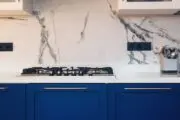
Previously the domain of gamers, the metaverse offers several practical applications for interior designers and builders, and by extension, homeowners, when designing and decorating homes.
Through metaverse platforms such as Spatial, Roblox, or Decentraland, end users can “drop in” via an avatar, experience home designs, and interact with other virtual visitors. Most platforms are accessible via a computer or smartphone.
The metaverse is big business for several well-known brands, such as Clinique, Ferrari, Dolce & Gabbana, Nike, Disney, Coca-Cola, and numerous others, embracing metaverse activations to sell products and deepen brand awareness through immersive experiences.
In the context of building and design, these overarching goals are the same, with the added benefit of communicating and demonstrating design concepts and options for homeowners because of the unique way the metaverse promotes a social-spatial relationship.
“You’re able to experience that space as if you are physically in it,” says Leslie Carothers, principal & founder of Savour Partnership.
The metaverse fulfills two essential needs in the design process: understanding spatial relationships authentically in a floorplan or design and efficiently collaborating and communicating with all the stakeholders in a build or design project.
Similarly, metaverse activations offer the convenience of access to products included in a design if the designer or builder has embedded links in their metaverse spaces.
What is the metaverse, and what does it represent for interior design?
Homeowners may already be familiar with AI, AR, and VR technologies to view homes, brainstorm design ideas, or shop for housing goods.
When touring model homes or viewing designer’s proposals virtually, homeowners may have viewed 3D models or renderings.
A metaverse space differs in that it is a” 3D model that is uploaded in full to the internet where people can view and tour through the model the same way you can locally on your computer,” says interior designer Annilee Waterman.
“A metaverse space is an interactive group space, just like a multi-player video game. You can join with your colleagues or friends from anywhere in the world. There are voice and text chat options, screen share, and streaming,” says Waterman.
Photorealism vs. immersion
It is important to note that while metaverse platform tech is undeniably cool and significant in its opportunity, it is nascent and has some limitations, notably in its photo realism. VR 3D models offer more authentic photographic representation, for example, regarding shade, shadow, color interplay, and variations. Comparatively, metaverse spaces are boxier in appearance.
Bandwidth is still limited, which means that “architecture and furnishings must be simplified, and materials reduced” in a metaverse space, says Waterman.
However, where the metaverse lags, it more than makes up with its ability to communicate scale and shape, which is why it is “best suited for the architectural design and space planning phase of interior design,” says Waterman.
It supports collaboration in a way that other immersive experiences do not, which is beneficial for a homeowner to meet interactively with their designer or builder and incorporate input from friends or family who want to weigh in on design choices. This is particularly helpful with multigenerational families or interested parties scattered about various locations.
It’s a simple but very distinct difference, according to Carothers.
Let’s say you are having a virtual meeting with your designer and other stakeholders to view a rendering of a design. While everyone technically sees the same thing on their screens, they aren’t touring the home together.
“You could be walking around in it, and I can be walking around, and I can even screen share and show you my experience, but you can’t enter at the same time as me as an avatar, go around in it, and gather at the same time in the same place,” says Carrothers. In contrast, you can upload your design to a metaverse platform.
It’s a time saver that helps homeowners narrow down decisions and be confident that their choices will allow them to create or choose a home they will love.
And, of course, when selecting tactile objects such as fabric or trying out a piece of furniture, it’s impossible to touch and feel in a metaverse space, but that is easily solved when décor and finishes are short-listed. A visit to a physical showroom or reviewing physical samples takes place in the project’s next phase.
This also underscores that in design, metaverse spaces are another tool in the designer-builder-homeowner relationship that enhances, rather than replaces, elements of the workflow. There is still a need for hands-on time to facilitate decision-making.
KB Home introduces its models in the metaverse
More interior designers have been including metaverse activations as part of their workflow, and builders are tapping into the metaverse too. KB Home is the first national builder to include a Metaverse activation, launching a welcome center and three model homes on the Decentraland platform in partnership with The Metaverse Group in early 2023.
House hunters can create an avatar and enter the welcome center, where they are met with a virtual host who provides general information about the homes and what they will see. The house hunter can proceed to tour each of the models, with options to customize home exteriors and mix and match finishes and materials, including counters, cabinets, flooring, lighting, wall color, and more. The “show homes” are furnished and styled with accessories.
There is the opportunity for numerous house hunters to be present simultaneously, taking a tour and discussing options through a chat or voice option.
The graphics hint at games that Gen Z and Millennials (key demographics in the homebuying market) would have grown up playing, so you can see the appeal and the strategy of offering a homebuying experience in this context.
In a statement, KB Homes said, “The metaverse represents yet another digital tool the company is tapping to engage with consumers and inspire them about the many possibilities of personalizing a new KB home. Within the virtual new-home community, visitors can explore design choices from exterior architectural styles to interior features as they create their unique vision of home.”








